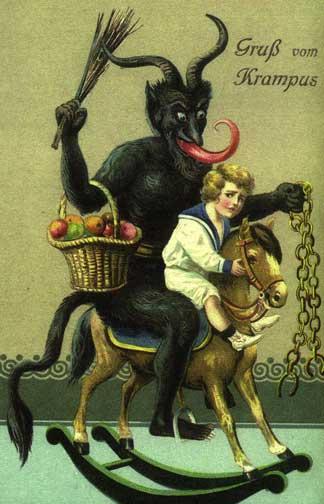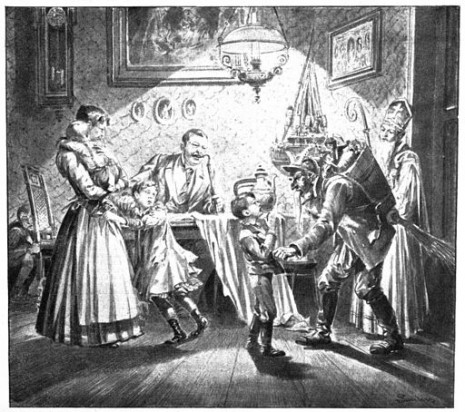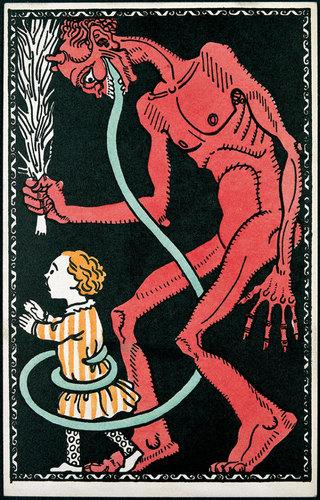Loyal readers may have noticed that I haven’t been posting very frequently recently. That’s because I have a looming book deadline (January 25th, to be exact). But as it’s the holidays, I thought I’d repost this piece I did a few years ago about the history of Santa-figures in other countries:
As a mother, I freely admit to having played the Santa card when my kids were younger. “Better stop fighting you guys. Santa is watching!” For years, that tactic scared them into submission and good behavior, at least around holiday time. But that type of psychological manipulation is pretty tame stuff, compared with what kids have had to endure in other places and times.
 Recently I did a post about the special genre of nineteenth century children’s books that taught morality and manners to children. The general idea behind these books was to scare kids witless in order to get them to behave. Today’s post is a holiday version of that genre; the various European traditions that turned Christmas into a form of Judgement Day. Good kids would get presents. Bad kids got punished in various creative and harrowing ways.
Recently I did a post about the special genre of nineteenth century children’s books that taught morality and manners to children. The general idea behind these books was to scare kids witless in order to get them to behave. Today’s post is a holiday version of that genre; the various European traditions that turned Christmas into a form of Judgement Day. Good kids would get presents. Bad kids got punished in various creative and harrowing ways.
This article in the New York Times breaks down some of these mostly-European Christmas traditions. In Iceland, naughty children were carted off by two thirteenth-century ogres and eaten. In Greece, mean imps jumped onto kids’ backs and forced miscreants to dance til they dropped. In France, Father Christmas (Pere Noel) had an evil sidekick named Pere Fouettard (loosely translated as “Father Spank-you.”)
 But for me, at least, the scariest is Krampus. He’s a demonic character from folklore common in Austria, the Netherlands, and Switzerland, with horns, hooves, and a long tongue. According to legend, Krampus joined Saint Nicholas on his Christmas rounds. While jolly old Saint Nick doled out gifts to the good kids, Krampus dispensed coal and swatted the pretty-bad with ruten bundles (birch branches), and then stuffed the especially naughty kids into his gunnysack and hauled them away, presumably to be eaten for his Christmas dinner.
But for me, at least, the scariest is Krampus. He’s a demonic character from folklore common in Austria, the Netherlands, and Switzerland, with horns, hooves, and a long tongue. According to legend, Krampus joined Saint Nicholas on his Christmas rounds. While jolly old Saint Nick doled out gifts to the good kids, Krampus dispensed coal and swatted the pretty-bad with ruten bundles (birch branches), and then stuffed the especially naughty kids into his gunnysack and hauled them away, presumably to be eaten for his Christmas dinner.

Images:
Top: a Greeting Card from the Krampus 1900 via Wikimedia
Middle: Krampus and Saint Nicholas in a Viennese home, 1896,
Bottom: an early twentieth century Krampus card